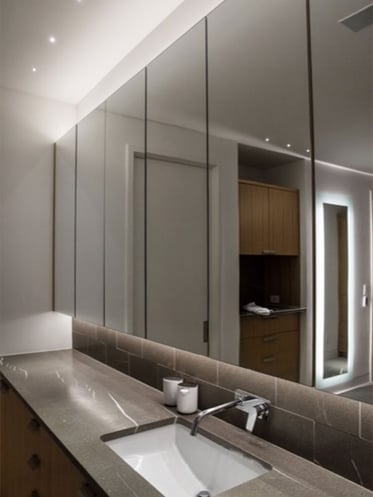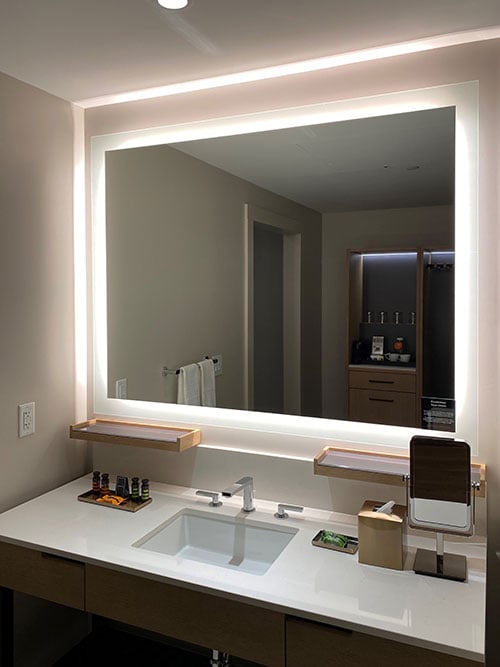Face Lighting Brings Out Your Best Look
Well-designed face lighting makes you look younger, healthier, even thinner.
The best lighting designs radiate and compliment you, wherever you are: at home, at the office, in a restaurant or hotel –anywhere and everywhere you are seen and want to be seen.
You may have little control over lighting in public spaces, but by understanding a few lighting design basics you can make it work to your advantage. In places you do control, working with a professional lighting designer can make you look better than you ever imagined.
The Personal Benefits of Lighting Design
Professional lighting designers enhance the spaces that interior designers and architects create. We transform them into visually interesting environments using a carefully calculated layering of ambient light, focal light, and sparkle lighting techniques.
The best lighting designs also make you look better in the process! Professionally designed lighting can absolutely make you look more youthful, slimmer, and more attractive.
Conversely, not working with an experienced lighting designer can result in improper or unflattering light that can make you appear older, heavier, or fatigued. And no one wants that.
Three Never-Fail Techniques for Facial Light
Ready to put your best face forward? Here are the top three body and face lighting techniques that will favor your features.
1. WALL SCONCES
Wall sconces put lighting at face level, where it enhances facial features. The last thing you want is light that grazes your face from above or below. Grazing merely skims the surface of your face, accentuating textures and features while leaving shadowy areas.
Lighting from above will graze your face, revealing every wrinkle and odd facial feature or skin imperfection. Lighting from below can look dramatically frightful, like when you are telling scary stories around a campfire with a flashlight at your chin.
These are two extreme examples but exemplify what can subtly happen when lighting instruments are in the wrong position. Lighting at face level washes out wrinkles and makes us look younger than overhead lighting.
 |
 |
Next time you are watching your favorite news channel, look closely into the eyes of the newscaster on the screen. The network or station is purposefully using lighting to maximize the good looks of the individual for the sake of ratings.
In the eyes of the on-camera person you will see the reflection of the lighting instruments being used. You can decipher the number of light sources and approximately where they are located. Most use at least two light sources a little higher than face level.
Some add one light below face level, uplighting the face (known as the “network facelift”) and some even have two above and two below for a total of four. The desire is to wash out the wrinkles from the shadows but leave a bit of soft shadowing from the chin onto the neck.
In a room, sconces placed at eye level work the same way to provide even face lighting that minimizes shadows. Likewise, natural light coming through windows can light faces evenly, depending on the direction of the sun.

2. INDIRECT LIGHTING
Up-lighting a ceiling creates a softer look for lighting faces than downlighting, but it’s not as effective as light at face level. That’s because the ceiling is the real lighting instrument, and it is higher than a wall-mounted sconce.
Indirect lighting is a great choice for the “other technique.” Here’s a tip: generally, it takes three-to-four lighting techniques make a space visually interesting. Indirect light can be one of those techniques, but not the only one.
 |
 |
Indirect lighting is also a great way to make people look their best in hospitality spaces without the use of mirrors. Hotel ballrooms are a great example of this. Customarily there are downlights, but there are also chandeliers, wall washers, sconces, and ceiling coves to get a soft ambient glow with a small level of shadowing.
Indirect doesn't just mean reflecting light off the ceiling. Bouncing lighting off the walls creates indirect lighting too, filling in shadows from lower levels. Try both techniques.
3. ILLUMINATED MIRRORS
One of the most important places to have good lighting is staring right at you – in the mirror. This is where we scrutinize ourselves as we prepare to go out and meet the world.
In general terms, face lighting should come from face level at 45 degrees from the face on both sides and provide 600-800 lumens on each side. This formula has never disappointed. It will ensure the best light for makeup, shaving, and for trimming stray hairs and eyebrows.
Illuminated mirrors have a wide variety of styles and shapes including square, rectangular, or round. Some have a frosted band at the edge of the mirror or within the reflection area.

Other mirrors have a full-perimeter illuminated element, and still others have just the top and bottom or just two sides to provide lighting. Each offers a slightly different aesthetic for the face.
Most hotels go for the full square or rectangle, while residential spaces often use the vertical bars of light or the two horizontal bars of light as an adequate, sensible choice.
 courtesy of electricmirror.com
courtesy of electricmirror.com
Other Variables for Body and Face Lighting
We humans are vertical beings; we see vertical surfaces first. Because we stand vertically, this principle applies to all your personal surfaces.
Only a small percentage of the population looks better when grazed with light – the young and fit crowd. The shadows created by their bodies enhance the human form, whereas most of us prefer soft, more even light that does not emphasize our often misplaced curves.
Even the young and fit can look terrible if grazing light is on the face. Harsh shadows create a severe look, which creates an unflattering impression of that person.
Light Color Matters
While considering the role of directional lighting in creating a flattering self-image, don’t forget the color temperature of the lights. The right Correlated Color Temperature (CCT) makes skin tones look healthy and feeds the general emotional energy of the space.
The Kruithof Curve is our favorite because it indicates how low CCT values look great with low light levels and high CCT values look great with high CCT values. We’ll discuss more about CCT in a subsequent article.
Conclusion
Lighting design can have a meaningful impact on a person’s image and beauty. A room can be beautiful, but when people look beautiful in a beautiful space, you have the best of the best.
Professional lighting designers have the power to deliver a more youthful and healthier glow by using three design techniques for body and face lighting – wall sconces, indirect lighting, and illuminated mirrors.
Light ON!


